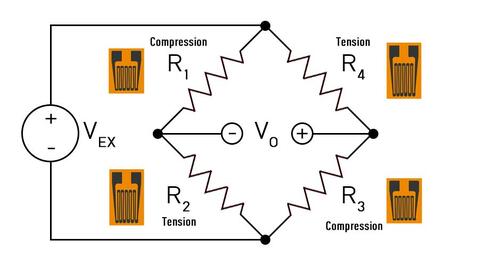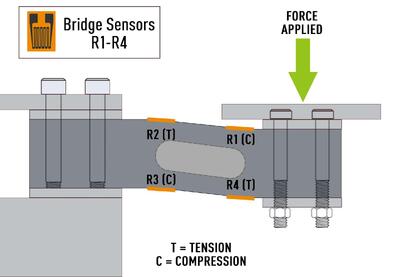How Does A Load Cell Work? Understanding The Key Principles
January 27, 2025

The successful functioning of many industries depends heavily on the precision and reliability of force measurement systems. Since the majority of industrial weighing and force measurement systems are load cell-based, it is important to have a basic understanding of how a load cell functions. So then, how do load cells work, and what makes them so indispensable? In this guide, we’ll break down the principles behind load cells, explore their functionality, and highlight their importance in a variety of industries.
Understanding the Basics of Load Cells
What is a Load Cell?
A load cell is a transducer that measures force and converts it into an electrical signal. Commonly used in industrial applications, load cells can detect various types of forces, including tension, compression, pressure, and torque.
How Does a Load Cell Work?
Load Cell Working Principle
Strain gauge load cells measure force by utilizing strain gauges bonded to the body of the load cell to form a Wheatstone bridge circuit. When a force is applied to the load cell, the body deforms slightly, causing the strain gauges to either stretch or compress. This deformation changes the electrical resistance of the strain gauges. The Wheatstone bridge circuit detects these resistance changes as variations in voltage, which are directly proportional to the applied force.
Force Measurement
The basic working principle of a load cell described above—using strain gauges to detect deformation and convert it into an electrical signal—adds significantly to its versatility and ability to measure different types of forces in the following ways:
- Sensitivity to Multiple Force Types:
Load cells can be designed to measure various types of forces, including compression, tension, shear, bending, and torsion. The flexibility in design allows the same fundamental principle to be applied to different force configurations. - Scalability for Various Force Ranges:
By selecting appropriate materials and strain gauges, load cells can be tailored to measure forces ranging from a few grams (e.g., in precision balances) to several tons (e.g., in industrial applications). - High Precision:
The Wheatstone bridge circuit amplifies small changes in resistance caused by deformation, enabling precise measurement. This precision makes load cells suitable for demanding applications, such as aerospace or medical equipment. - Adaptable Design Configurations:
The strain gauge and load cell structure can be modified to suit specific applications. For example, single-point load cells are used in platform scales, while S-type load cells handle tension and compression forces. - Compact and Durable:
The compact size and robust construction of load cells allow them to be integrated into various systems, from small electronic devices to large industrial machinery, without compromising reliability. - Ease of Signal Processing:
The electrical output from the strain gauges can be easily amplified, filtered, and processed for digital or analog systems. This makes load cells compatible with modern data acquisition and control systems. - Ability to Handle Dynamic Forces:
Load cells are not limited to static force measurements; they can also respond to dynamic or fluctuating forces, making them suitable for real-time monitoring in industrial and research applications.
By combining these attributes, load cells offer a versatile and reliable solution for force measurement across a wide range of industries and applications.
Strain Gauge Technology
Strain gauge technology is fundamental to the operation of most load cells. Strain gauges are thin electrical resistors that change resistance when stretched or compressed. In a load cell, these gauges are bonded to an elastic element.
As force is applied, the element deforms, causing the strain gauges to experience tension or compression. This change in resistance is then converted into an electrical signal using a Wheatstone bridge circuit. Strain gauge load cells are favored for their high accuracy and reliability in various industrial applications.
Elastic Deformation
Elastic deformation refers to the temporary change in the shape of a material when a force is applied. In load cells, the deformation occurs in the elastic element (often made of metal), which flexes under load but returns to its original shape once the force is removed. This property allows for repeated measurements without permanent changes to the sensor's structure.
The degree of deformation correlates directly with the applied force, making it possible to accurately measure weight or force through electronic signals generated by attached strain gauges.
Wheatstone Bridge Circuit
The Wheatstone bridge circuit is used to measure small changes in resistance due to strain. It consists of four resistors arranged in a diamond shape, where two resistors are connected in series on each side.
When a load causes deformation in the strain gauges (acting as resistors), an imbalance occurs that results in a measurable voltage difference between two points of the circuit. This voltage difference is proportional to the applied force and allows for precise calibration and measurement of weight or tension.


Temperature Compensation
Temperature compensation maintains accuracy in load cell measurements, as temperature variations can affect resistance readings and lead to measurement errors. Load cells often incorporate temperature sensors or use materials with low thermal coefficients to minimize these effects.
Manufacturers guarantee consistent performance by adjusting the output signal based on temperature readings. This helps the load cell maintain accuracy across varying environmental conditions.
Non-Linearity and Hysteresis
Non-linearity refers to the deviation of the output signal from a straight line over the entire measurement range; ideally, this should be minimal for accurate readings. Hysteresis occurs when there is a difference in output during loading and unloading. This can lead to discrepancies in weight measurements if not accounted for during calibration.

Sensitivity
Sensitivity in load cells refers to their ability to detect small changes in force or weight relative to their output signal. It is typically expressed as the ratio of change in output voltage per unit change in applied force (e.g., mV/V). High sensitivity enables precise measurements even at low loads. This makes it vital for applications requiring fine resolution, such as laboratory scales or precision manufacturing equipment.
Creep and Drift
Creep and drift are important considerations when assessing load cell performance over time. Creep refers to the gradual change in output signal under a constant load over time due to material relaxation or deformation processes within the sensor structure.
Drift involves slow changes in output that occur even without any change in applied load, often caused by temperature fluctuations or electronic noise. Both phenomena can affect long-term accuracy and reliability; therefore, regular calibration and monitoring are necessary to mitigate their impacts.
Output and Calibration
The output of a load cell typically consists of an electrical signal proportional to the applied force, which can be calibrated for specific applications. Calibration involves comparing the output signal against known weights or forces to establish an accurate relationship between input (force) and output (signal). This process makes sure that measurements remain consistent and reliable across various operating conditions.
How Load Cells Impact Industries
Industrial Applications of Load Cells
Load cells are used in industrial applications such as weighing systems, material testing, and process automation. They are commonly employed in truck scales, platform scales, and batching systems to guarantee accurate measurements of goods. In manufacturing, load cells monitor the weight of raw materials and finished products, helping to maintain quality control.
Load Cells in Process Control
In process control applications, they share real-time feedback on the weight or force applied during various operations, enabling automation systems to make immediate adjustments. For instance, in chemical processing, load cells make sure that the correct amounts of materials are used in reactions. They enhance product consistency and reduce waste.

Advancements in Load Cell Technology
Recent advancements in load cell technology have improved their performance and application scope. Innovations include enhanced sensitivity and accuracy through advanced strain gauge designs and materials that reduce hysteresis and non-linearity. Wireless load cells are gaining traction. They allow for easy installation and real-time monitoring without the need for extensive wiring.
Unlock the full potential of your industrial processes with cutting-edge load cell technology from Load Cell Central. If you need precision in force measurement or advanced solutions for process control, our team is here to offer expert guidance and reliable products tailored to your needs.
Contact us today to learn more or request a quote!